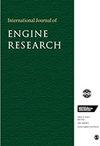为生物气柴油 RCCI 发动机开发新型双喷射器概念并进行实验验证
IF 2.1
4区 工程技术
Q2 ENGINEERING, MECHANICAL
引用次数: 0
摘要
双燃料 RCCI 发动机在使用柴油的同时使用生物气等低反应活性的可再生燃料,可以减少氮氧化物的排放,同时实现高效率运行。一般来说,柴油以脉冲方式喷射,一次很早,另一次接近 TDC。如果使用传统的广角柴油喷射器进行提前喷射,则会导致壁面湿润,从而产生较高的 THC 和 CO,并对效率产生不利影响。在这项工作中,对喷射器组合进行了评估,其中一个喷射器之间的角度较窄,另一个喷射器之间的角度较宽(NW 喷射器),分别用于沼气柴油 RCCI 发动机的早期和接近 TDC 喷射。使用经过验证的 CFD 模型进行模拟,以确定合适的喷射参数,包括喷孔的方向、窄角喷油器 (NI) 的喷孔数量、窄角喷油器和宽角喷油器之间的燃料分配比例、喷射时间和喷射压力。研究表明,窄角喷油器的喷油必须喷到活塞缸体的外围,以获得良好的混合气制备效果。喷嘴对准活塞缸外围的三孔 NI 配置可使燃油沉积最少、效率最高、烟尘和 HC 排放最低。随后制造了 NI,将其安装在发动机上,并在沼气柴油 NW RCCI 模式下进行了实验,以确定其性能和排放,并将其与单广角喷油器 RCCI(WI RCCI)模式进行比较,以挖掘其潜力。本文章由计算机程序翻译,如有差异,请以英文原文为准。
Development and experimental validation of a novel twin injector concept for a biogas diesel RCCI engine
A bi-fuel RCCI engine that uses a low reactivity renewable fuel like biogas along with diesel can decrease the NOx emissions and at the same time operate with high efficiency. Generally, diesel is injected in pulses, one very early and the other close to TDC. The early injection if done with conventional wide angle diesel injectors leads to wall wetting resulting in high THC, CO and adversely affects the efficiency. In this work a combination of injectors, one with a narrow angle between the sprays and the other with a wide angle between the sprays (NW Injectors) was evaluated for early and near TDC injections respectively in a biogas diesel RCCI engine. Simulations with a validated CFD model were used to determine the suitable injection parameters including the orientation of the spray holes, number of holes of the Narrow angle Injector (NI), fuel split ratio between narrow and wide injectors, injection timing and injection pressure. The studies indicated that the NI sprays have to hit the periphery of the piston bowl for good mixture preparation. The 3-hole NI configuration with the sprays aimed at the periphery of the piston bowl resulted in minimum fuel deposition, highest efficiency, and lowest soot and HC emissions. The NI was subsequently manufactured, installed on the engine and experiments were conducted in the biogas diesel NW RCCI mode for determining the performance and emissions and for comparing the same with the single Wide angle Injector RCCI (WI RCCI) mode in order to bring out its potential.
求助全文
通过发布文献求助,成功后即可免费获取论文全文。
去求助
来源期刊

International Journal of Engine Research
工程技术-工程:机械
CiteScore
6.50
自引率
16.00%
发文量
130
审稿时长
>12 weeks
期刊介绍:
The International Journal of Engine Research publishes high quality papers on experimental and analytical studies of engine technology.
 求助内容:
求助内容: 应助结果提醒方式:
应助结果提醒方式:


